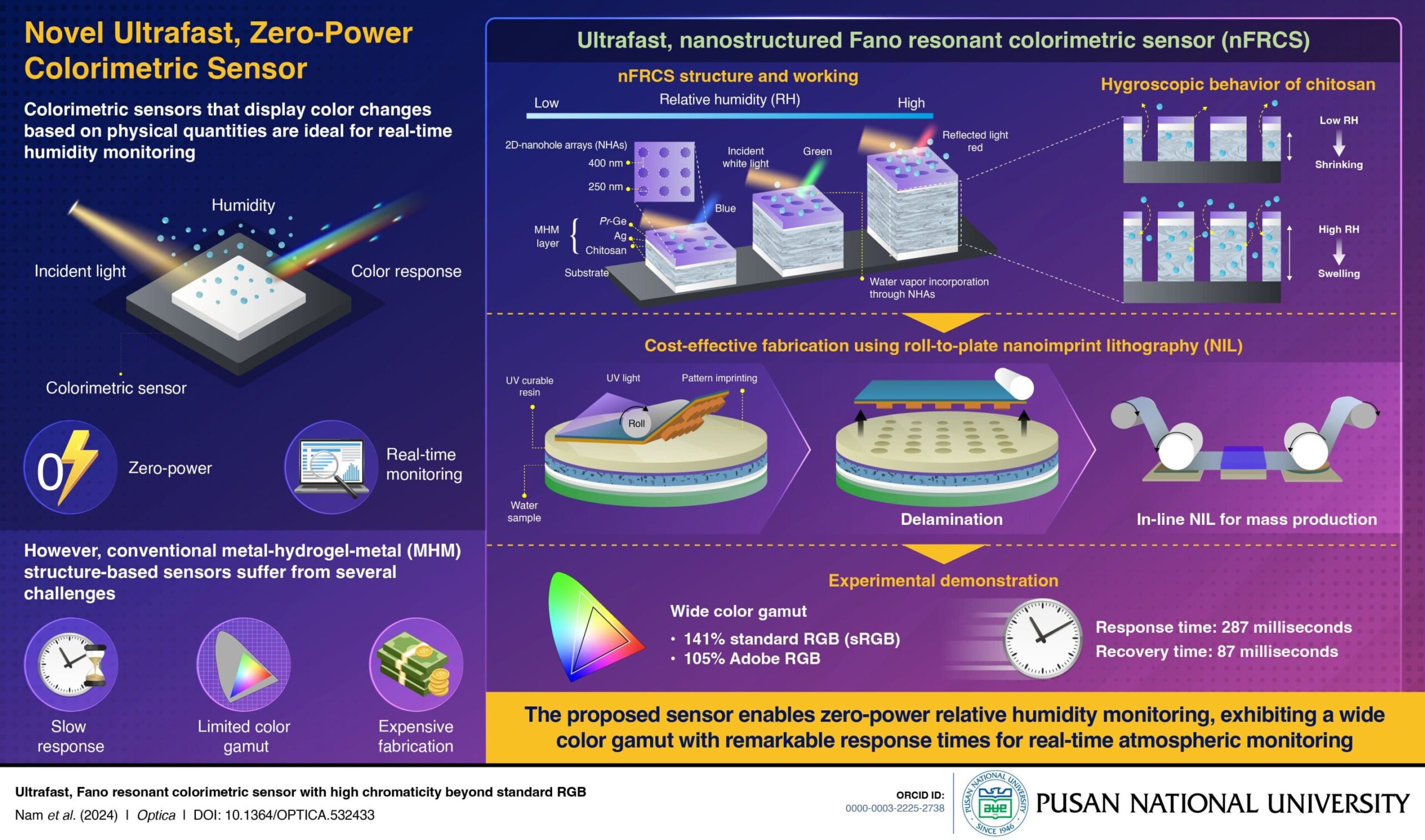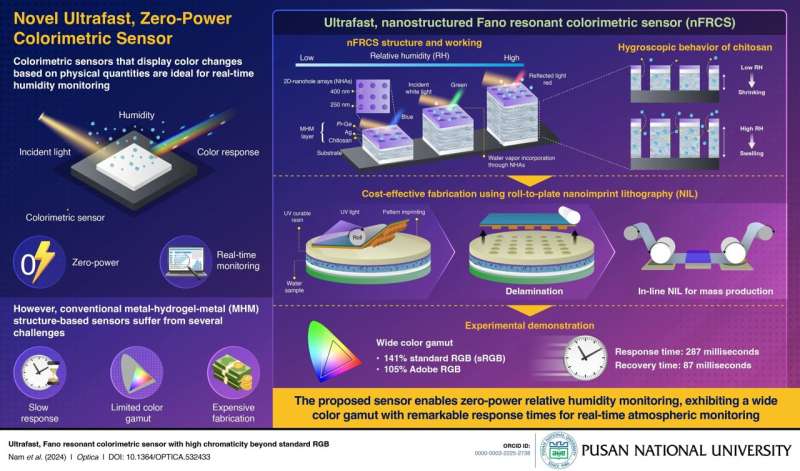

Colorimetric sensors detect environmental changes by intuitively shifting colors, easily visible to the naked eye without the need for additional equipment. Furthermore, they operate with zero power consumption. By shifting color visibly, without any need for additional equipment, these sensors have the potential to play critical roles in applications like food packaging and ancient artifact preservation, where optimal humidity is crucial for quality control.
For accurate humidity detection, colorimetric sensors must cover a wide range of colors, demonstrate a linear correlation between color and humidity, respond quickly, and maintain long-term stability. Sensors that achieve coloration through structural changes are generally more advantageous than chemical reaction-based sensors.
Among these, metal-hydrogel-metal (MHM) structures utilizing Fabry-Pérot resonance stand out due to their simplicity and diverse color generation, as changes in the hydrogel cavity’s thickness, often using swelling materials like chitosan, lead to different colors. However, conventional designs still suffer from limited color representation and slow responsiveness.
Addressing these issues, a research team from South Korea, led by Associate Professor Gil Ju Lee from the School of Electrical and Electronics Engineering at Pusan National University, has developed an innovative two-dimensionally (2D) nanostructured Fano resonant colorimetric sensor (nFRCS).
Dr. Lee explains, “Our design introduces nanohole arrays that utilize Fano resonance and plasmonic resonances, significantly enhancing color gamut by controlling the reflectance spectrum from subtractive coloration to additive coloration. Furthermore, these nanohole channels also enhance responsiveness.” The findings are published in the journal Optica.
The nFRCS comprises an MHM structure of silver-chitosan-silver with a thin upper layer and thick bottom layer. The MHM also has a thin, porous germanium (Pr-Ge) coating. This coating is a key addition that transforms the MHM from a Fabry-Perot resonator to a Fano resonator, significantly improving color representation.
Additionally, nFRCS incorporates 2D nanohole arrays (NHAs) into the MHM layer that establish a direct route for water vapors in the ambient environment to reach and interact with the chitosan layer. Due to the hydrophilic nature of chitosan, in highly humid conditions, the chitosan absorbs water molecules, causing it to swell, and in dry conditions releases water molecules, shrinking its volume, resulting in a humidity-level-dependent color change.
These NHAs also improve the sensor’s responsiveness, and their orderly pattern facilitates additional light-matter interactions such as surface plasmon resonance (SPP) and local surface plasmon resonance (LSPR), further boosting performance.
The researchers fabricated the nFRCS sensor using roll-to-plate nano-imprint lithography (NIL), which uses a stamping-like method to transfer the nanoscale patterns onto the MHM layer. Compared to conventional expensive nanostructure fabrication techniques, this method saves both time and cost.
In experiments, the fabricated nFRCS showed a wide color gamut, exceeding the standard RGB (sRGB), showing 141% sRGB coverage and 105% Adobe RGB coverage, outperforming previous studies. Moreover, it demonstrated outstanding responsiveness with response and recovery times of 287 and 87 milliseconds, respectively.
Highlighting the broader applications of the sensor, Dr. Lee says, “Beyond humidity sensing, the nFRCS can also serve as health monitoring devices, intelligent displays, and interior materials, reacting to external stimuli by generating distinct color shifts. This design could serve as a framework for other types of colorimetric sensors that detect different environmental changes other than humidity.”
Overall, this innovative sensor marks a significant leap forward for zero-power real-time environmental monitoring.
More information:
Hee Jun Nam et al, Ultrafast, Fano resonant colorimetric sensor with high chromaticity beyond standard RGB, Optica (2024). DOI: 10.1364/OPTICA.532433
Provided by
Pusan National University
Citation:
Fast-responding colorimetric sensor for real-time monitoring has expanded color gamut (2024, October 18)
retrieved 18 October 2024
from https://phys.org/news/2024-10-fast-colorimetric-sensor-real-gamut.html
This document is subject to copyright. Apart from any fair dealing for the purpose of private study or research, no
part may be reproduced without the written permission. The content is provided for information purposes only.